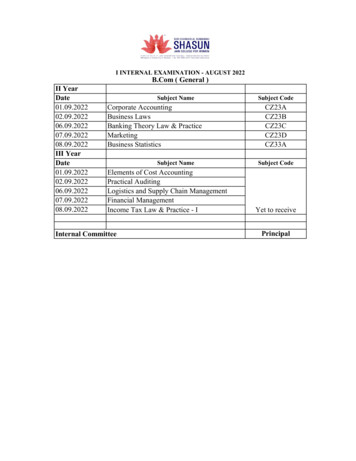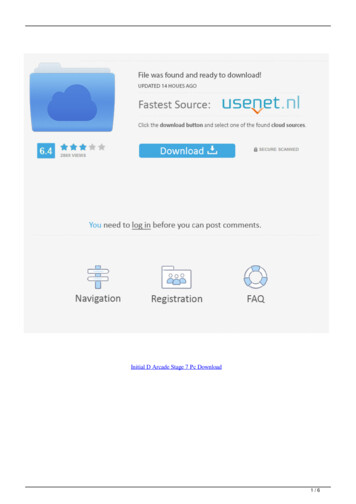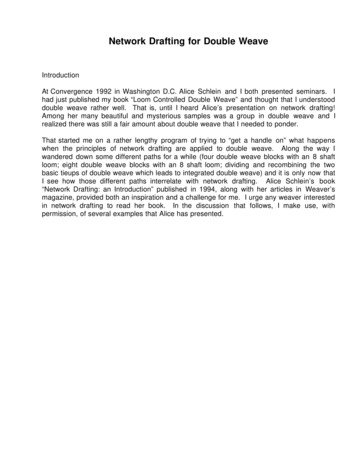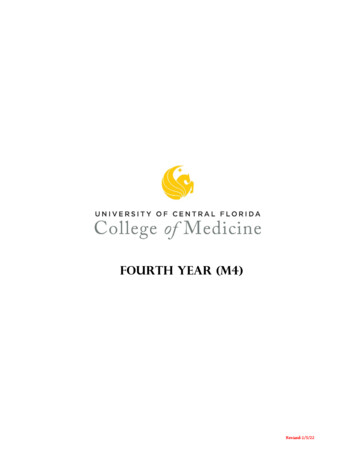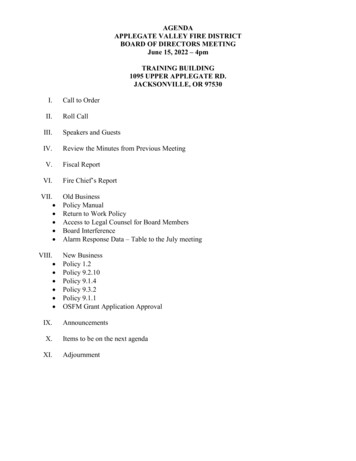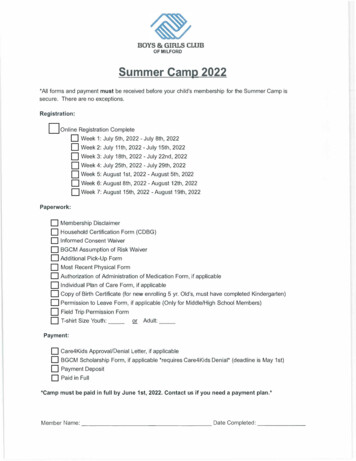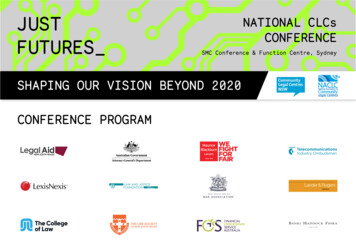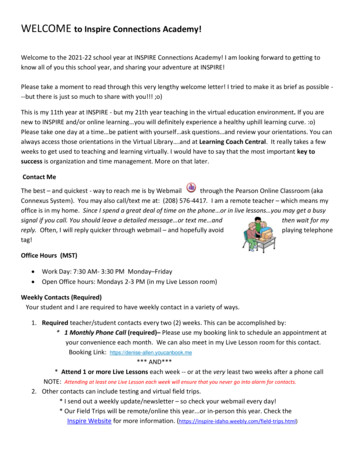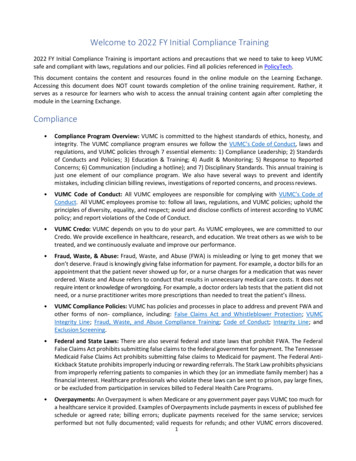
Transcription
Welcome to 2022 FY Initial Compliance Training2022 FY Initial Compliance Training is important actions and precautions that we need to take to keep VUMCsafe and compliant with laws, regulations and our policies. Find all policies referenced in PolicyTech.This document contains the content and resources found in the online module on the Learning Exchange.Accessing this document does NOT count towards completion of the online training requirement. Rather, itserves as a resource for learners who wish to access the annual training content again after completing themodule in the Learning Exchange.Compliance Compliance Program Overview: VUMC is committed to the highest standards of ethics, honesty, andintegrity. The VUMC compliance program ensures we follow the VUMC’s Code of Conduct, laws andregulations, and VUMC policies through 7 essential elements: 1) Compliance Leadership; 2) Standardsof Conducts and Policies; 3) Education & Training; 4) Audit & Monitoring; 5) Response to ReportedConcerns; 6) Communication (including a hotline); and 7) Disciplinary Standards. This annual training isjust one element of our compliance program. We also have several ways to prevent and identifymistakes, including clinician billing reviews, investigations of reported concerns, and process reviews. VUMC Code of Conduct: All VUMC employees are responsible for complying with VUMC’s Code ofConduct. All VUMC employees promise to: follow all laws, regulations, and VUMC policies; uphold theprinciples of diversity, equality, and respect; avoid and disclose conflicts of interest according to VUMCpolicy; and report violations of the Code of Conduct. VUMC Credo: VUMC depends on you to do your part. As VUMC employees, we are committed to ourCredo. We provide excellence in healthcare, research, and education. We treat others as we wish to betreated, and we continuously evaluate and improve our performance. Fraud, Waste, & Abuse: Fraud, Waste, and Abuse (FWA) is misleading or lying to get money that wedon’t deserve. Fraud is knowingly giving false information for payment. For example, a doctor bills for anappointment that the patient never showed up for, or a nurse charges for a medication that was neverordered. Waste and Abuse refers to conduct that results in unnecessary medical care costs. It does notrequire intent or knowledge of wrongdoing. For example, a doctor orders lab tests that the patient did notneed, or a nurse practitioner writes more prescriptions than needed to treat the patient’s illness. VUMC Compliance Policies: VUMC has policies and processes in place to address and prevent FWA andother forms of non- compliance, including: False Claims Act and Whistleblower Protection; VUMCIntegrity Line; Fraud, Waste, and Abuse Compliance Training; Code of Conduct; Integrity Line; andExclusion Screening. Federal and State Laws: There are also several federal and state laws that prohibit FWA. The FederalFalse Claims Act prohibits submitting false claims to the federal government for payment. The TennesseeMedicaid False Claims Act prohibits submitting false claims to Medicaid for payment. The Federal AntiKickback Statute prohibits improperly inducing or rewarding referrals. The Stark Law prohibits physiciansfrom improperly referring patients to companies in which they (or an immediate family member) has afinancial interest. Healthcare professionals who violate these laws can be sent to prison, pay large fines,or be excluded from participation in services billed to Federal Health Care Programs. Overpayments: An Overpayment is when Medicare or any government payer pays VUMC too much fora healthcare service it provided. Examples of Overpayments include payments in excess of published feeschedule or agreed rate; billing errors; duplicate payments received for the same service; servicesperformed but not fully documented; valid requests for refunds; and other VUMC errors discovered.1
VUMC is committed to the prompt investigation, reporting, and refunding of identified overpayments.Clinicians and employees at ALL levels are responsible for reporting potential Overpayments. If you thinkyou see an Overpayment, notify your supervisor immediately. Otherwise, you may contact your RevenueCycle Manager. You are also always free to contact the VUMC Office of Compliance & Corporate Integrityif you are unsure of or uncomfortable with usual methods. Failure to return or properly investigateoverpayments can have serious consequences, including allegations of fraud. (Policies: Overpayments,Federal Healthcare Programs and Overpayments: Commercial Plans) Reporting: Fraud, Waste and Abuse (FWA) and Code of Conduct violations may result in disciplinaryaction, up to and including termination. All VUMC employees must report suspected FWA andviolations of the Code of Conduct, law or VUMC policy. All reports are confidential and shared only ona need-to-know basis. There are several ways to report or to just ask a compliance question. Speakwith your supervisor. If you are not comfortable with this, you can contact the VUMC Integrity Line (24hours a day, 7 days a week) by phone at 866-783-2287 or online. You do not have to leave your name.You can also contact VUMC’s Compliance Office by phone at 615-343-7266 or email atcompliance.office@vumc.org. Health and Human Services (i.e., the federal government) can becontacted. For more information on reporting options, see the Compliance Reporting job aid. Non-Retaliation: VUMC depends on you to report known or suspected violations of the law or the Codeof Conduct. Whistleblowers make reports of suspected violations they believe to be true.Whistleblowers are protected from being fired, demoted, suspended, harassed, or suffering retaliationfrom any kind. However, false accusations made with the intent of harming or retaliating against anotherperson can subject the accuser to disciplinary action. (Policy: False Claims Act and WhistleblowerProtection.)2
Protecting Patient PrivacyWe are all responsible for protecting patient privacy. At VUMC, our patients and their families are our #1 priority.Failure to keep patient information private can cause patients to feel unsafe, damage our reputation, and it isagainst the law. HIPAA: The Health Insurance Portability and Accountability Act (HIPAA) is a federal law that protectspatient privacy and thiall “individually identifiable health information” held or transmitted by a coveredentity or its business associates, in any form or media, whether electronic, paper, or oral. HIPAA callsthis information “protected health information (PHI).” PHI is any information in a patient’s medicalrecord that was created, used, or disclosed during diagnosis, treatment, or billing that can be used topersonally identify the patient. It is our responsibility to protect PHI and follow HIPAA for all patients. HIPAA Violations: The federal government investigates HIPAA violations and can impose fines. Thesefines can be high enough to cause practices, clinics, and hospitals financial hardship and harm theirreputations. Employees that violate HIPAA can be disciplined up to and including termination. Curb You Curiosity: Never access a patient’s medical record if you are not involved in the patient’s careor or the information is needed to do their job. (Policy: Sanctions for Privacy and Information SecurityViolations) eStar: With eStar, we can quickly and easily identify and address patient privacy issues. Our eStarplatform provides regular notification and reporting about potential breaches of privacy. The PrivacyOffice regularly conduct audits and reviews. Accessing Medical Records: Never modify your own electronic medical record. Accidental or intentionalopening of multiple patient records to find the correct patient record is a violation of HIPAA. If you openthe wrong patient’s record, contact the VUMC Privacy Office to document the error. (Policy: Authorizationto Access Medical Records: Self and Others) Break-the-Glass: eStar uses a tool called Break-the-Glass. The pop-up screen means you must provideyour VUMC ID and password along with a valid reason for accessing this patient’s record. All instancesof breaking the glass are reported to the Privacy Office. The Break-the-Glass pop-up appears for specialprotected groups and for all VUMC employees. Adding an explanation can reduce the need for furtherinvestigation by the Privacy Office. (Policy: Use and Disclosure of Protected Health Information) Communication with Family and Others: Information should not be shared with anyone unless thepatient has given permission by completing the Communication with Family and Others (CFO) form. Thecompleted form is stored in the eStar Media tab. Discussing Patient Care: Discuss patient’s care in private locations. Make sure you will not be overheard.Ask patients, every time, if it is okay to talk with them about their medical care with others in the room.Only discuss patients’ care with the patient’s healthcare team or those approved on the CFO form. Whenleaving messages for a patient, do not reveal any information to anyone that is not on the CFO form.(Policies: Use and Disclosure of Protected Health Information and Protection and Security of ProtectedHealth Information and Disposal of Confidential Information) Special Protected Groups: Access to patient records for employees, persons of interest, and high-profilepatients is closely monitored. Persons of interest are patients including individuals such as celebrities,political leaders, franchise or business owners, and headline news makers. (Policies: Use and Disclosureof Protected Health Information and Social Media) Breach Response Team: For certain violations, the Breach Response team decides if the employee willreceive a warning or be fired. The Breach Response team consists of designated leadership from thefollowing offices: Privacy; Office of Legal Affairs; Risk and Insurance Management; Human Resources;3
Patient Relations; Chief of Clinical Staff, VUMC, or their designee Chief of Staff; VUMC Enterprise Security(VEC) (if the incident involves access to PHI through an electronic information resource); the departmentadministration where the violation occurred; and others as indicated. Handling Documents: Human error is the most common reason for HIPAA violations. When it is time tothrow away a document with PHI, place it in a Shred-It bin for disposal. When mailing information,double check the envelope address before mailing to be sure it is correct. Ask the patient for their nameand date of birth before handing information to the patient (i.e., discharge instructions, appointmentlists, prescriptions, etc.). Call the VUMC Privacy Office as soon as you realize a mistake was made. (Policy:Electronic Messaging of Individually Identifiable Patient and Other VUMC Confidential or SensitiveInformation) Using Workstations: Do not use eStar to look at patient records unless you are listed on the CFO form.Always log off or lock your computer when you walk away. Never share your ePassword with anyone.Turn your screen away from public areas. Leaving your computer unlocked, which allows someone toaccess PHI through your user ID, is a serious violation that may lead to termination. (Policies: Protectionand Security of Protected Health Information and Disposal of Confidential Information) Sending Electronic Messages: Only use your mobile device (smart phone) for VUMC business if you havethe Mobile Device Management (MDM) app enabled. Follow this link for MDM instructions. Sending textmessages or instant messages with PHI between clinicians is only allowed through approved apps suchas Mobile Heartbeat. Sending a text or instant message with PHI to the patient is only allowed if thepatient is warned of the risks and provides consent. To be safe, only send information that you wouldbroadcast over a speaker system. Emailing: Use Accellion or MS Outlook Sensitivity labels to encrypt an email attachment that containsPHI, clinical, or confidential information. If you need to send a patient an email, useMyHealthatVanderbilt.com. Before you share patient information with a non-VUMC workforce member,be certain you are authorized to do so. If you are unsure, contact the Privacy Office. Images and Video Files: Use the EPIC Haiku phone app when taking videos or photos of patients fortreatment purposes. The app protects image and video files from being accessed outside of the patient’smedical record. (Policy: Patient/Visitor Photography/Recordings and Use of Recording Devices toCapture Patients and Visitors) The Privacy Office is Here to Help: The VUMC Privacy Office is here to help. If you see something thatdoes not respect a patient’s privacy, talk with your manager or contact the VUMC Privacy Office by emailat privacy.office@vumc.org or by phone at 615-936-3595. To report anonymously, submit a Veritasreport or use the Integrity Line. Integrity Line: 866-783-2287. Veritas: veritas.app@vumc.org. By law, noone can retaliate against you for filing a complaint. (Policies: Protection and Security of Protected HealthInformation and Disposal of Confidential Information) Our Patient and Family Promise: We respect our patients’ and families’ right to privacy. As part of ourCredo, we also pledge to respect privacy and confidentiality. Confidentiality Agreement: To review the VUMC Confidentiality Agreement, click here.4
Cyber SecurityYou can help maintain cybersecurity. Using computers and mobile devices can be risky. There are people(hackers) that try to steal both information and money from VUMC by attacking our systems. The followinginformation will help you keep your computer and mobile devices safe from these attacks. Internet Browsing and Posting: When we visit a website, post online, click a link, or create an account,we create a trail of data that others can see. By following these simple rules, we can reduce the chancethat our Internet use could harm VUMC: Do not post or share any patient information including PHI on social media. Be mindful of what you post; you represent VUMC. Do not use your VUMC computer to visit websites that are not work-related.(Policies: Social Media and Acceptable Use) Passwords: Do not give out your password. No one at VUMC should ask you for it; allow others to seeyour password either written down or as you type it; or use your VUMC ID, Vanderbilt e-mail address,or Vanderbilt password on any accounts outside of VUMC. Protect VUMC and your own information bymaking a password that is difficult to guess. Examples of poor passwords include: p@ssw0rd1,Password123*, and 12345678!. Use a phrase that is easy for you to remember, but difficult for others toguess. (See Five Tips for Better Password Security) Phishing: Phishing is a method people use to try to steal information. They send an email, instantmessage or document with links or attachments. If we click or open them, they can have access toanything on our computer. This is often how identity theft occurs. Patient health information orconfidential research data could be stolen. It is often how hackers put viruses on computers or networks. Phishing Emails: An email may be phishing if it: Is from someone you don’t know. Is from someone you know or a VUMC employee, but just doesn’t seem right. Tries to pressure or scare you. Asks you to click a link or open an attachment. Asks for sensitive data. Tells a story that is too good to be true. Contains an unusual meeting request.Don’t click it! VUMC routinely sends test phishing emails. Additional testing will be assigned for thosethat click on links or provide information. Immediately forward potential phishing emails tophishing@VUMC.org or call 343-HELP to ask for guidance. Ransomware: Ransomware is software someone uses to block your access to your computer. Don’t payit and don’t try to fix it yourself by running anti-virus software and clearing your web history. If you geta pop-up message demanding money and your computer is locked, immediately stop using the deviceand call the VUMC Help Desk at 615-343-HELP to report the attack. Encryption: Encryption is a process that changes data to make it unreadable. To read the data, it mustbe encrypted with an electronic key, such as a passcode. Every device that is used for VUMC businessmust be encrypted. Devices include computers, laptops, thumb drives, and other types of external harddrives. If you need help encrypting files, contact the IT Help Desk (343-HELP). (Policy: Encryption ofDigital Information at VUMC) Working with Sensitive Data: It is our job, legally and ethically, to keep sensitive data safe. Sensitivedata includes personal identifiable information that can be used to identify, contact, or locate anindividual; all of the PHI in a patient’s medical or billing record; confidential research information5
including participant identities, protocols, and results; and financial information including purchasing,billing, and payroll. Sending Sensitive Data: Sometimes we need to send sensitive data to others who are authorized to haveit. Securely send sensitive data using: VUMC Box and MS OneDrive for Business can be used to securely share files with other VUMCemployees. When emailing sensitive files and data, use MS Outlook Sensitivity Labels. Accellion is an encryption service that can be used to email attachments securely. Storing Sensitive Data: Sensitive data should never be stored in areas that VUMC does not own orcontrol. Do not store sensitive data on unapproved cloud storage, unsecured smart phones, tablets andlaptops, or unencrypted thumb drives, memory cards, external hard drives and/or DVDs/CDs. Theinformation on those devices can be easier to steal. Follow these tips when storing sensitive data: Physically lock up devices and keep them out of sight. Lock or log off computers before stepping away. Be sure devices have automated locking enabled with passcode locks or screensaver locks. Avoid using removable storage devices. If a removable storage device must be used, encrypt thedevice. For help encrypting removable devices, contact the VUMC Help Desk. Use VUMC Box or MS OneDrive for Business for cloud storage. Use eStar to save patient data. Dispose of VUMC Computers and Devices Safely: Do not dispose of, sell, or donate VUMC devices.When it is time to dispose of your computer or other electronic devices, call the VUMC Help Desk (343HELP). Mobile device policy: You must use VUMC’s Mobile Application Management (MAM) or VUMC’s MobileDevice management (MDM) solution to access your VUMC application on your mobile devices. Thisincludes VUMC email. You will not be able to access your VUMC application without using MAM/MDM.Visit the VUMC IT website for more information and instructions.6
Hazard CommunicationThere are hazardous chemicals in many places at VUMC. You must know how to recognize them so that no onegets hurt. You also need to know about the chemical safety laws: the U.S. Occupational Safety and HealthAdministration (OSHA) Hazard Communication Standard and the Tennessee Hazardous Chemical Right to KnowLaw. Note that this training does not provide chemical-specific training. Get training whenever a new hazard isintroduced to your work area. You manager can help you learn how to stay safe when working with hazardouschemicals. Do not use a chemical unless you have been trained on how to work with it safely! Recognize Chemical Hazards: Chemicals can be dangerous for lots of reasons. Some chemicals createphysical danger, such as chemicals that can burn or explode. Some chemicals are dangerous to yourhealth, such as a poison or strong acid. These chemicals can hurt you right away. Sometimes damagefrom a chemical does not show up for a long time. It might be days, weeks, months, or even years beforeyou realize you have been hurt by the chemical. When the damage does not show up right away, it iscalled a delayed health effect. Cancer is a delayed health effect as it may take years for cancer to develop.Just because a chemical doesn’t hurt you right away, doesn’t mean it is safe. Chemical Hazard Categories: There are many kinds of chemical hazards: Flammable chemicals burn easily (i.e., isopropyl alcohol). Some chemicals can explode (i.e., TNT). Self-reactive chemicals must be kept refrigerated. If they get too warm, the give off gases thatcan explode and catch fire. Oxidizers are chemicals that give off oxygen and can make a fire spread (i.e., hydrogen peroxide). Water-reactive chemicals react with water to give off flammable gases. They must be kept awayfrom water (i.e., sodium metal). Pyrophoric chemicals will catch fire if they are exposed to oxygen in the air. Compressed gases and liquids are under very high pressure. If these containers break open, theycan explode (i.e., oxygen gas in a cylinder and liquid nitrogen).The “Recognize Chemical Hazards” reference is available at the end of this course. Health Hazards: An asphyxiate is a gas or vapor that can suffocate you so you cannot breath. This can happen intwo different ways: 1) oxygen can be forced out of the room by another gas; or 2) a chemicalcan stop your body from using oxygen. Corrosive chemicals cause chemical burns to skin and eyes and will dissolve metal. Carcinogens cause cancer. Toxic chemicals (toxins) will make you sick or cause death. A toxin may attack one or more partsof the body, such as the liver, kidneys, nerves, lungs, skin, eyes, or bone. Reproductive or genetic toxins: when men or women are exposed to these toxins, it can makeit hard for them to have children. Mutagens cause injuries to DNA that are passed on to children(affects men and women). Teratogens cause birth defects if a woman is exposed while pregnant. Irritants are chemicals that can damage skin or eyes but will heal. Respiratory tract irritants can cause inflammation in the lungs, nose, larynx, and trachea. Sensitizers cause allergies on skin or when breathed in. Routes of Exposure: Hazardous chemicals can get on or inside your body many ways. A chemical can gothrough injured skin. Some chemicals can even enter your body through healthy skin. You can breathein gases, dusts, and mists. A liquid can splash into your eyes, mouth, or nose. Chemicals can also enteryour body if you eat or drink around them. Never eat or drink in areas where chemicals are used orstored. Always wash your hands after working with chemicals. Recognize Chemical Hazards: If a chemical might be dangerous, it is labeled to warn you. The company7
who sells the chemical provides a report that tells you how to safely use the chemical. That report iscalled a Safety Data sheet (SDS). Each department where chemicals are used keeps a list of all thechemicals they have. There will be an SDS for every chemical on the list. Safety Data Sheets (SDSs): Each chemical product has an SDS that tells you how to work safely with achemical. It also tells you what to do if there is an accident and lists information that will help your doctortreat you. The SDS has 16 sections, and every SDS lists the same kind of information in the same section(see the OSHA Quick Guide and this Safety Data Sheet reference to learn more). Contact OCRS if you havequestions about hazardous chemical disposal or transport. All safety data sheets must be available toeveryone at all times. Never store safety data sheets in a locked cabinet. Keep Your SDSs Handy: You never know when an accident will happen, so you always need access toyour SDSs. Everyone in the department must be able to access them at any time. Do not lock them upin an office unless everyone can get in. Keep local copies. They can be printed out and kept in a binderor in a computer file format. If the SDSs are computer files, back them up. Do not depend on an onlinewebsite for your SDSs. Find Your Safety Data Sheets: Most companies who sell chemicals provide their SDSs online. If you haveproblems finding a SDS, the Office of Clinical & Research Safety website has resources to help you. AtVanderbilt Wilson Country Hospital, SDSs are kept on the SharePoint website. If the site is down, staffcan contact the Emergency Department for a printed copy. Pictograms: Pictograms are symbols used to warn you about chemical hazards. They are used onchemical labels and in Safety Data Sheets (SDSs). Many of them represent more than one kind of hazard.These pictograms tell you that a chemical may be dangerous. Chemical hazard pictograms are also usedon shipping containers. Pictograms used on container labels have a red border. Shipping container labelsuse different colors, but the symbols mean the same things. See the pictogram reference chart for moreinformation. Chemical Labels: Read the chemical label before working with a chemical. It contains the productidentifier, hazard statements, supplier information, signal words, and precautionary statements. If youmove a chemical to a new container, you must copy what was listed on the first container onto a labelfor the new container. This way you can make sure everyone knows if the chemical might be dangerous.The Office of Clinical and Research Safety (OCRS) website has resources to help you make your ownlabels that comply with the law. Personal Protective Equipment (PPE): You wear some kinds of safety equipment. This equipment iscalled personal protective equipment (PPE). PPE includes special protective clothing and devices thatyou wear to protect yourself. The safety equipment you need depends on the chemical you are workingwith and the type of exposure you are at risk to. The kind of safety equipment and PPE you need to usewill be described in the SDS for the product. Skin Protection: Some chemicals can hurt you if they get on your skin. To prevent this, you need to wearPPE that the chemical cannot go through. You will need to wear gloves, and you may need to wear morePPE, such as a lab coat, coveralls, or a suit with a head cover. Not all gloves will protect your hands fromall chemicals. For instance, latex gloves do not protect you from solvents. Be sure that the kind of glovesyou have will protect you from the chemicals you need to work with. Eye Protection: If the chemical might splash into your eyes, you will need splash goggles or a face shield.Wear a face shield to protect against splashes to eyes, nose, and mouth. Safety glasses are not the sameas goggles. Glasses are open at the sides and will not protect you from a splash. Respiratory Protection: Some chemicals are dangerous to breathe. To work with those chemicals, youmust use respiratory protection. This may mean that you work at a fume hood, which pulls the hazardousfumes away from you. It may mean that you need to work in an area with lots of fresh air. It may mean8
you need to wear a respirator. Respirators are not one size fits all and there are many different kinds.Contact OCRS to help you figure out if you need to wear a respirator. If you need a respirator, OCRS staffcan help you find the right kind and teach you how to put it on so it will work. Important: OSHA requiresa health check before you can wear a respirator. Vanderbilt Occupational Health Clinic will do this check. Stay Safe from Chemicals: There is equipment you can use to keep safe when you work with hazardouschemicals. Always use available safety equipment. Some equipment is built in, like a chemical fumehood. Use the fume hood if you are working with a chemical that is dangerous to breathe. If you do nothave a fume hood, use the chemical in a large open area with lots of fresh air, so you will not get sick.Use SOPs and follow the steps to work safely with a chemical. Always store chemicals properly and donot keep chemicals that react in the same place. PPE Guidelines: Protective clothing and equipment are not one size fits all. Make sure gloves,respirators, and all PPE you wear fits you well. If your PPE can be reused, be sure to clean and maintainit properly so that it will continue to provide protection. Never eat or drink in areas where chemicals areused or stored. Always wash hands very well after removing gloves or any other kind of PPE. If you needhelp picking out the correct PPE, talk to your supervisor or contact OCRS. Hazard Signs: Hazard warning signs are posted outside all labs on the VUMC campus. If you see one, donot enter the lab without first checking with lab staff. Where are the Chemicals? Chemicals are in every clinical and research building. There are chemicals inlabs, chemicals used for cleaning, and many hazardous drugs, such as chemo drugs. Every car, truck, andhelicopter contains fuel. Be aware of where chemicals are stored. The Chemical List includes all thechemicals used or stored in a department or unit. Refer to your department’s Chemical List to find outwhat chemicals are used or stored there. Detecting Hazardous Chemicals: It is important to know if there is a hazardous spill or a hazardous gasgets out. Find out if there is anything special about the chemical you work with that will help you spot aleak or spill. For instance, some chemicals have a distinct small or color. Emergency Response: Evacuate anyone near the spill area, then block off the area by closing doors orin some other way if the spill is in a hallway. Get a copy of the Safety Data Sheet for the chemical. At theVUMC main campus or One Hundred Oaks, notify Vanderbilt Police, OCRS, and Facilities Management.At Vanderbilt Wilson Country Hospital, notify security and Environmental Services. At other locations,notify your manager and others as needed. If a hazardous chemical gets on you: Remove any clothing that has the chemical on it.Flush with lots of water for a least 15 minutes. Do not use water if the SDS tells you the chemicalis not safe if mixed with water.Go to the Occupational Health Clinic or the Emergency Department. You will need to tell themwhat chemical you were exposed to for proper treatment.Give a copy of the SDS for that chemical to the healthcare provide
You can also contact VUMC's Compliance Office by phone at 615-343-7266 or email at compliance.office@vumc.org. Health and Human Services (i.e., the federal government) can be contacted. For more information on reporting options, see the Compliance Reporting job aid.

